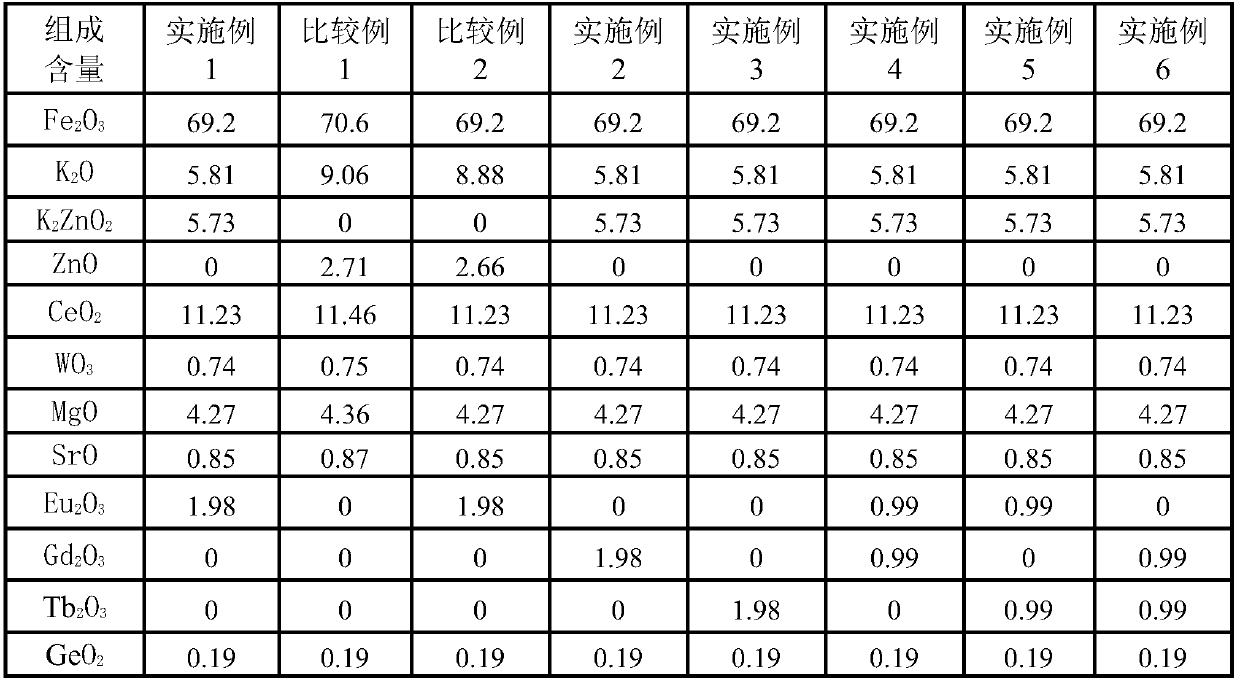Catalyst for ethylbenzene dehydrogenation in low steam to ethylbenzene ratio, preparation method and application thereof
A technology of ethylbenzene dehydrogenation and catalyst, which is applied in the direction of catalysts, carbon compound catalysts, chemical instruments and methods, etc., can solve the problems of poor stability of catalysts, achieve the effects of improving stability, enhancing stability, and enhancing self-regeneration ability
- Summary
- Abstract
- Description
- Claims
- Application Information
AI Technical Summary
Problems solved by technology
Method used
Image
Examples
Embodiment 1
[0052] would be equivalent to 50.2 parts Fe 2 o 3 iron oxide red, equivalent to 19.0 parts Fe 2 o 3 Iron oxide yellow, equivalent to 5.81 parts K 2 Potassium carbonate of O, 5.73 parts of K 2 ZnO 2 , equivalent to 11.23 parts of CeO 2 of cerium nitrate, equivalent to 0.74 parts of WO 3 ammonium tungstate, magnesium hydroxide equivalent to 4.27 parts of MgO, 0.85 parts of SrO, 1.98 parts of Eu 2 o 3 , 0.19 GeO 2 Stir in a kneader with 5.4 parts of graphite for 1.5 hours, add deionized water accounting for 28% of the total weight of the catalyst raw material, stir for 0.5 hour, take out the extruded strips, extrude them into particles with a diameter of 3 mm and a length of 6 mm, put them into an oven, 60 ℃ for 2 hours, 130 ℃ for 3 hours, then placed in a muffle furnace, calcined at 650 ℃ for 3 hours, and 920 ℃ for 3 hours to obtain the finished catalyst. The catalyst composition is listed in Table 1.
[0053] 100 milliliters of catalysts are loaded into the reactor, a...
Embodiment 2
[0061] Except with Gd 2 o 3 Replace Eu 2 o 3 Outside, catalyst preparation method and catalyst evaluation condition are with embodiment 1, specifically:
[0062] would be equivalent to 50.2 parts Fe 2 o 3 iron oxide red, equivalent to 19.0 parts Fe 2 o 3 Iron oxide yellow, equivalent to 5.81 parts K 2 Potassium carbonate of O, 5.73 parts of K 2 ZnO 2 , equivalent to 11.23 parts of CeO 2 of cerium nitrate, equivalent to 0.74 parts of WO 3 ammonium tungstate, magnesium hydroxide equivalent to 4.27 parts of MgO, 0.85 parts of SrO, 1.98 parts of Gd 2 o 3 , 0.19 GeO 2 Stir in a kneader with 5.4 parts of graphite for 1.5 hours, add deionized water accounting for 28% of the total weight of the catalyst raw material, stir for 0.5 hour, take out the extruded strips, extrude them into particles with a diameter of 3 mm and a length of 6 mm, put them into an oven, 60 ℃ for 2 hours, 130 ℃ for 3 hours, then placed in a muffle furnace, calcined at 650 ℃ for 3 hours, and 920 ℃ f...
Embodiment 3
[0064] In addition to using Tb 2 o 3 Replace Eu 2 o 3 Outside, catalyst preparation method and catalyst evaluation condition are with embodiment 1, specifically:
[0065] would be equivalent to 50.2 parts Fe 2 o 3 iron oxide red, equivalent to 19.0 parts Fe 2 o 3 Iron oxide yellow, equivalent to 5.81 parts K 2 Potassium carbonate of O, 5.73 parts of K 2 ZnO 2 , equivalent to 11.23 parts of CeO 2 of cerium nitrate, equivalent to 0.74 parts of WO 3 ammonium tungstate, magnesium hydroxide equivalent to 4.27 parts of MgO, 0.85 parts of SrO, 1.98 parts of Tb 2 o 3 , 0.19 GeO 2 Stir in a kneader with 5.4 parts of graphite for 1.5 hours, add deionized water accounting for 28% of the total weight of the catalyst raw material, stir for 0.5 hour, take out the extruded strips, extrude them into particles with a diameter of 3 mm and a length of 6 mm, put them into an oven, 60 ℃ for 2 hours, 130 ℃ for 3 hours, then placed in a muffle furnace, calcined at 650 ℃ for 3 hours, an...
PUM
 Login to View More
Login to View More Abstract
Description
Claims
Application Information
 Login to View More
Login to View More - R&D
- Intellectual Property
- Life Sciences
- Materials
- Tech Scout
- Unparalleled Data Quality
- Higher Quality Content
- 60% Fewer Hallucinations
Browse by: Latest US Patents, China's latest patents, Technical Efficacy Thesaurus, Application Domain, Technology Topic, Popular Technical Reports.
© 2025 PatSnap. All rights reserved.Legal|Privacy policy|Modern Slavery Act Transparency Statement|Sitemap|About US| Contact US: help@patsnap.com



